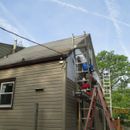Repairing roof nail holes
I am having siding installed, and the installers are using a scaffold built with two ladders, each ladder attached to a single 2×4, and the 2×4 is nailed with two nails to the roof.
First, is this considered a routine type of scaffold? Or would knowledgeable people be upset about nails in the roof?
Second, what is the most durable repair? Roof jacks appear to be installed by lifting shingles and only creating nail holes under the shingle. Then the nail is pounded in and sealed. So, there is no exposed hole.
I have not inspected closely yet, but I think in this case, the nails do go through the exposed part of the shingle. So would the best be for replacement of any shingles with holes?
Thank you.
GBA Detail Library
A collection of one thousand construction details organized by climate and house part










Replies
Erich,
1. You probably don't want OSHA to see that staging setup.
2. There are lots of ways to repair nail holes in asphalt shingles. Most roofers would just lift the tab and put a little squirt of asphalt roofing cement (dispensed from a caulk gun) on the hole before folding the tab back down. If you wanted to be a little more conscientious, you could cut out a little 3"x3" piece of asphalt felt and use that (along with a big glob of asphalt roofing cement acting as glue) on top of the hole but under the tab.
Thank you Martin. The holes were filled with Quad OSI which sounds like a quality sealant, though the website states it should not be used to fill nail holes. Once I get a ladder standoff I will see if felt can be added under the shingles with holes.
I think they did quality work, and am glad I did not do it myself. I would feel better if they used a safer setup. I use safety equipment such as a ladder stabilizer, and the strongest class of fiberglass ladder available.
Thanks for your advice.
Those guys win the prize for questionable scaffold setup. Hopefully everyone that stepped on that thing had workers comp coverage and no way to sue you or your homeowners insurance company.
To see how it's really done, google "ladder jacks" and "pump jacks".
Oh Dave, you know they're not even in contention for the prize. But they're certainly meatheads.
They did use a ladder scaffold for some areas. I think working on the side of the house may not have been possible with the ladder scaffold because the ladder could not lean against the sloped roof, but don't know.
I have a Qualcraft Basemate ladder stabilizer which is excellent, and am buying the Ladder Max standoff.
When the roof is replaced I will definitely ask about safety standards.
Safety equipment seems cheap relative to the risks.
Dan,
Loved your comment: "You know they're not even in contention for the prize."
.
Yeah, the confusion of "survived" with "safe" is a remarkable intellectual feat.
To be fair, their platform looks to be about four feet above grade.
The ladder is perhaps four feet up from the ground, and the maximum may have been around 12 feet.
When I asked about the strength of two nails holding up the ladder, I was told most of the weight and pressure are toward the ground.
In some of the photos Martin posted, I don't understand how a person could climb those ladders without knocking them down.